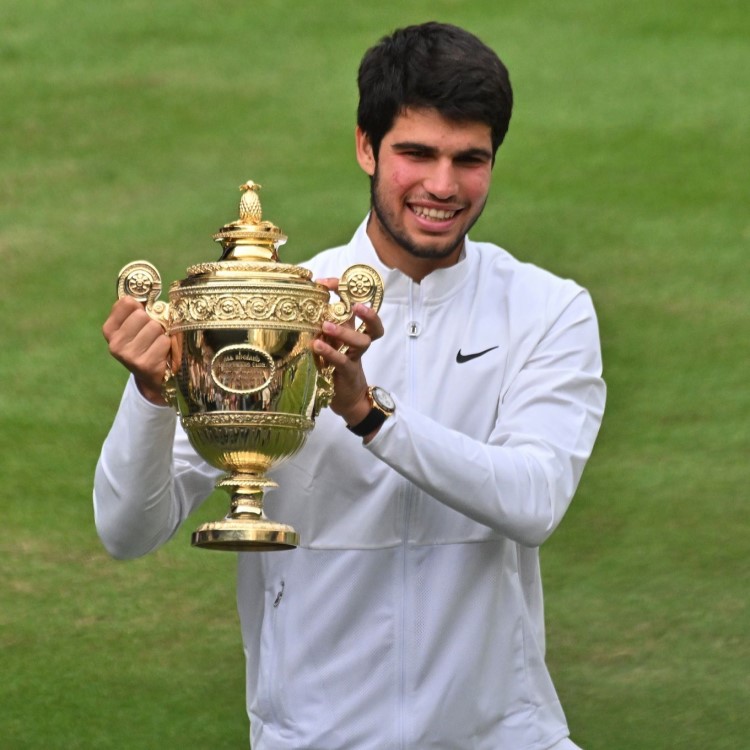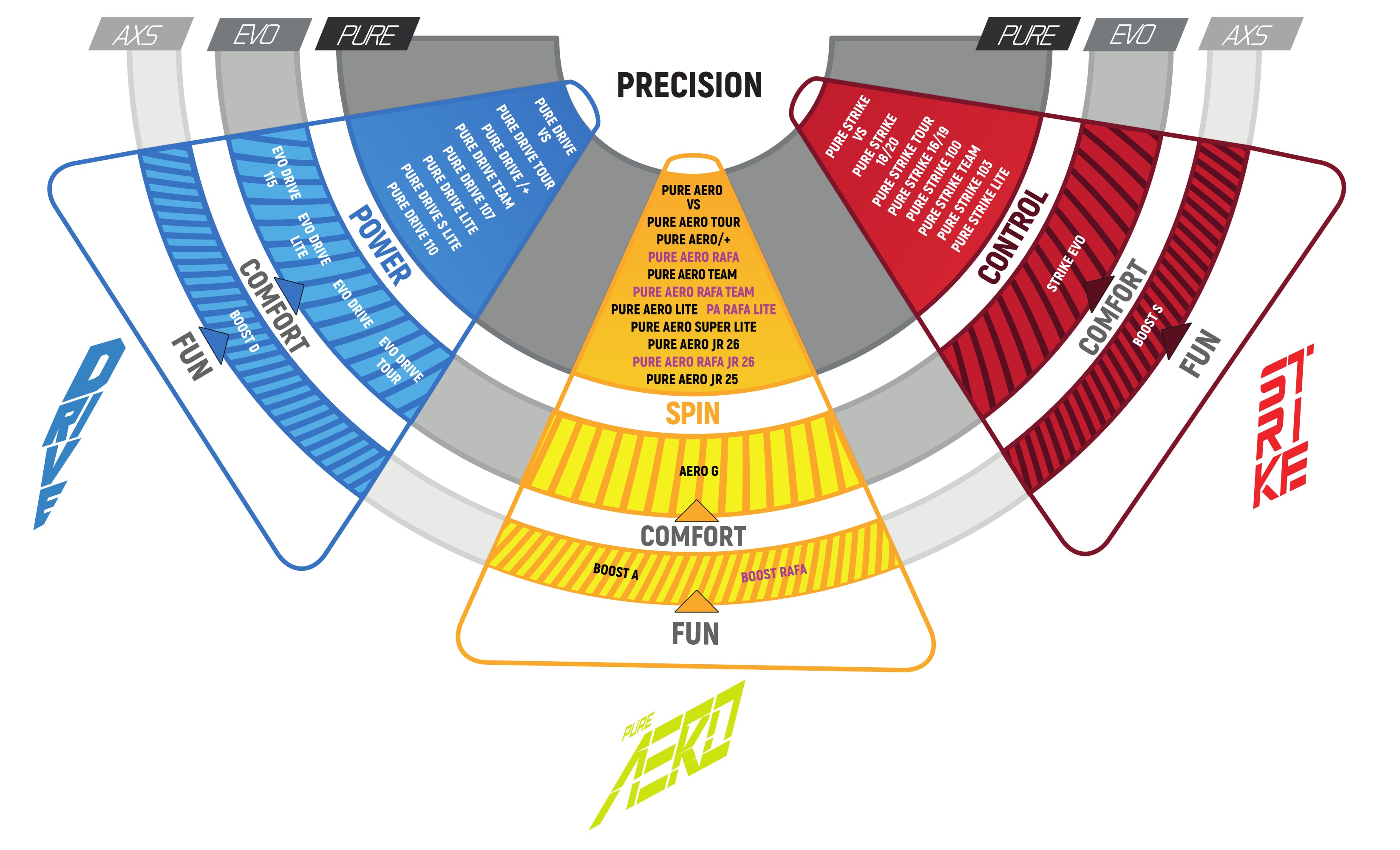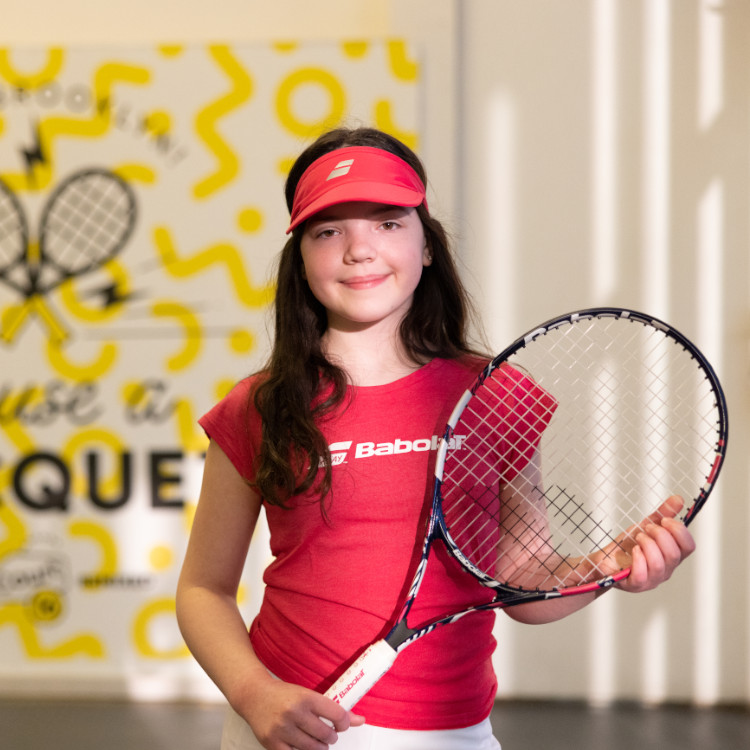
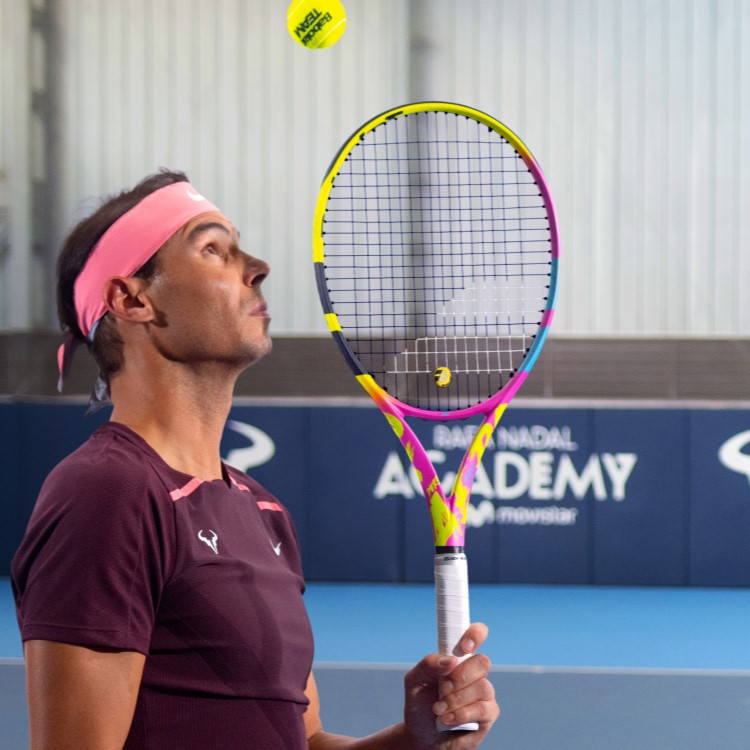
Does a Tennis Racket Make a Difference to Your Game?
Wondering if a new racket will impact your tennis performance, or if it’s all down to technique? We interviewed a respected Auckland tennis coach who said “you will really notice the difference of a new racket if you’re an experienced player or returning social player. Also, if you’re taking the plunge and buying a new racket after giving tennis a shot for a few months, a new racket can really elevate your performance. However, if you’re getting back into it and just hitting softly with a 5 or 6 year old child, you won’t notice a huge difference with a fancy racket."
A Mum and social player named Marie resisted the suggestions from her coach to upgrade her racket. She was convinced her technique was the culprit. After struggling to regain her former consistency, she finally invested in rackets for her teenage son (playing high school interclub), and herself (playing socially).
The upshot? They both noticed a tremendous improvement in their game. They seriously upped the fun factor, power (in her son’s forehands), and ground-stroke top-spin consistency. As a result, they play two or three times a week together. “It's great quality time (and it also gets him away from his computer).” Marie laughs.
“You’ll get much more enjoyment with a racket that matches your ability and playstyle,” says Auckland proshop coach.
Tennis Rackets for Beginner Players
Getting the best tennis racket as a child, youth or adult beginner makes it easier to master the basics.
Best Tennis Rackets for Beginner Children
“Far too often, kids turn up with 1 of 3 things; a racket that’s too small, one that’s too big/too old/too heavy (Mum or Dad’s one from the ‘90s), or a poor quality $40 job from a cheap store,” says former Frontrunner tennis expert Alastair Chapman. “We’re trying to remove barriers to play. Kids won’t enjoy it so much if they don’t have the right racket.”
As a total beginner, aged between 4 to about 9 years of age, learning the fundamentals of the game “is easier on a cheaper lightweight aluminium racket with a big sweet spot, such as the Babolat B’Fly or Ballfighter", says the Auckland tennis coach. This racket style helps to build confidence and get them hitting the ball more consistently. Alastair concurs, suggesting “a good starting point for child beginners is the Babolat Ballfighter, available in all sizes for $74.99.”
Star power undeniably adds a cool factor to brands. As children aspire to emulate legends like Rafael Nadal. Babolat’s Nadal Junior range with Rafa’s distinct colourway is one of Babolat’s top-selling ranges. It has a racket in every size, and is ideal for young children learning on an orange or red ball (balls specifically designed for beginner players), with longer models extending all the way up into youth options.
Once your child can rally and play three quarter court at Hot Shots orange level or is transitioning from orange to green ball, the 25 inch Drive for a 7-8 year old or the 26 inch Aero are graphite composite options, if you’re looking for a racket that will last a little longer. The Aero “gets a little player into a cool racket that will give them a lot of feel and control,” according to the Auckland tennis coach. “If you hit it in the middle, the ball goes deeper into the court. It will help your kid if they’re playing against someone who is still on just an aluminium racket.” This racket twinkles with star power as well: 20-year-old Spaniard Carlos Alcaraz beat Djokovic at Wimbledon in 2023 with a Babolat Pure Aero 98.
TENNIS RACKETS FOR BEGINNER YOUTH PLAYERS
For a youth beginner, the Babolat Boost range is an excellent place to start.
TENNIS RACKETS FOR ADULT BEGINNER PLAYERS
For an adult beginner, a Boost Aero or, for a racket that will see you further, a lightweight Pure Aero or Pure Drive is a sure-shot. Pure Drive is an all-rounder; it suits everyone, followed by the Aero.
It pays to understand that a beginner racket is a temporary investment.
TENNIS RACKETS FOR INTERMEDIATE PLAYERS
You know you’re an intermediate player if you have progressed to be playing competitive tennis or you’re serving, rallying, scoring and striking easily.
As children grow taller and stronger, they will need a longer racket to match their height. When you know your child is committed to playing tennis, they are playing at green ball (this is the third level of ball, after red and orange, after which children get to play with a normal yellow ball), it’s time to move up to at least a full-spec lightweight tennis racket.
Typically children get a second tennis racket between age 9-14 and the aim is to get a lighter model. A good example is the Babolat Boost for $220. It’s a full size, lightweight racket and a really good racket at that price point for full graphite that plays really well.
Boost comes in 5 models and three weights. For a Junior 9-14, we recommend the 260g or 270g model. For 13 and 14 year olds, who are not as strong in their game yet, the 280g Boost Strike is a solid option.
An alternative if budget is less of a constraint, or in a more high-performance space for stronger players would be the lighter, full-graphite frame Babolat Pure Aero Lite or Pure Drive Lite racket (Or for more developed players, a Pure Strike Lite).
You could go for the 255g Pure Drive Super Lite, popular for women or lighter builds. The Pure Drive is the main all-rounder in Babolat’s range. The Pure Aero - for power and spin - is more and more forgiving with each new model released. The Pure Aero range starts at the 270g Pure Aero Lite, followed by the Pure Aero Team (285g), then the standard Pure Aero at 300g (a weight popular with experienced players). The Pure Drive Team 285g racket is popular with female players, adults and teens. Relative to the Aero, it’s head heavy and gives more power.
In summary, transitioning to a racket like the Boost or Drive is a wise decision if your coach indicates your child is underpowered in their current gear. Getting an intermediate racket with some graphite in the frame enables you to develop your game and learn more about tactics and spin.
Tennis Rackets for Interclub Players
If your child is playing interclub and it’s their first season, it makes sense to move from an aluminium to a graphite racket; the ball comes off the strings better. The most popular Babolat for this level is the Boost racket for a 12-13 year old playing in a team, because it’s a full-sized lightweight racket. It has a slightly larger head which means more shots go in, due to its bigger sweet spot.
The moment you start playing in tournaments, (12 and 14 year olds are the biggest group), the Mums and Dads get keen and get coaching. Those are the years you’ll get children buying a racket or a spare in case they bust a string in a tournament. The next range up from Boost is the lighter Babolat Pure Aero or Pure Drive.
A good all round choice is the Babolat Pure Drive (comparable to Wilson Pro Staff or Head Speed). The Pure Drive delivers power and comfort. The Drive will work and is loved because you can strike the ball hard without it always going over the back fence. The Pure Aero still has power but it is more spin orientated.
The 285g Pure Aero Team is a weight that many females or lighter-weight teens from 14 onwards use (good for teens who haven’t yet fully filled out). Stronger players could use a 285g if they want a bit of manoeuvrability at the net. This racket will last longer if you’re a lighter build, and the lighter weight means your arm won’t get so tired. It’s more of an even balance, rather than head heavy.
Developed or experienced female players should use a 300g Pure Drive or Pure Aero.
The Pure Aero comes in many weights; 275g unstrung (strings add 10-15g) is one of the lightest adult rackets. It suits a junior transitioning from 26” to a 27” racket. It’s a little bit head heavy which gives a bit of power as you transition.
If budget is something to be mindful of, the Evo range retails between $300-$360. It’s a forgiving range due to the slightly oversized head and reduced weight.
Tennis rackets for teenagers or youth players
Younger teens who are lighter in build, may mature and fill out in their mid to late teens with more body mass, meaning they will be able to handle a heavier racket that facilitates more power and spin. Typically, a 16-year-old boy has a mature physique.
When your child’s physique matures, they can swing a bigger racket with more oomph, are playing a gutsier game, and hitting with more length, “you get him/her a cannon rather than a pea shooter,” explains Pro shop coach Alastair.
A suitable “cannon” might be a Pure Strike, a Pure Aero, or Pure Drive in 300g.
Drive vs Aero vs Strike
The Drive delivers speedy, fast serves and shots that will leave your opponent’s quaking with fear! “Drive” is your cue for power.
The Aero is a fatter frame. The way Nadal and Alcaraz hit the ball with an Aero, the racket is quick through the air. It gets more head speed for top spin. “Aero” in the name is your cue for a ball spinning through the air.
The Strike is a slightly narrower beam when you look at it front on, with a thin frame which flexes a bit more and holds the ball better, making it a good choice for a perfectionist who likes accuracy and control.
Tennis rackets for adults returning to tennis
Perhaps you are playing tennis with your children or coming back to tennis after a break. Racket technology has moved on so much from a generation or two ago, and so have the strings (the engine of the tennis racket).
Most older rackets have never been restrung, are 30 years old, and have factory strings that have spent a long time deteriorating on the racket. If you can’t afford a new racket, you need to restring. Your grip likely needs replacing too. Marie wound her new grip on the old racket on the wrong way. Duh! “It was a waste of time and money,” Marie lamented, “as in the end, I bought a new racket which was lightning years ahead of the old one and increased my enjoyment three-fold.”
The most popular of the Babolat racket range is the Boost; $220 for a beginner to intermediate women’s racket. The mid-tier Evo range retails for $300-360, depending on model, and has a nice big head (large sweet spot for consistency). Both are good rackets but the Evo has some aspects of a top end racket; it will go through the air a bit better because the beam is thinner.
For a more experienced player, the Pure Aero is a step up again, and is renowned for spin and accuracy. Women or smaller-build men might opt for the lighter 285g Pure Aero Team. Experienced men typically go for 300g. Anything over 300g such as the 317g Pure Aero Rafa Origin are for generally for advanced players. A stronger woman might opt for 300g. If you want more depth to your shots, consider a Pure Drive to get killer power, but this is not advisable if you’ve had tennis elbow.
Tennis rackets for advanced players
All models in the Pure range are top end and good for advanced players.
The Babolat 98/97 range in Aero, Drive and Strike gives a full feel, but isn’t as forgiving as the main Pure range. It’s a rock hard, narrower racket, and it can hurt your elbow. A good player who is looking for as close to a pro-level racket as you’ll get, will love the full feel and control. The Aero 98 is the friendliest of the lot; used by Carlos Alcaraz.
The 317g Pure Aero Rafa Origin is modelled off Rafa's exact specs. It’s the ‘marquee’ (most expensive racket in the range), and is new in 2023. This racket is only for technically expert players. The number one player in NZ is playing 312g so the Origin is a heavy frame. The 290g Pure Aero Rafa can be used by good players who want a bit more playability.
The Pure Strike 97 is a popular – and serious - racket that suits higher level players or good high school players who are leaving high school and carrying on playing competitively. A Strike 97 is the most aggressive racket in the Babolat range; it has a smaller head size, and is the heaviest, designed for stability, power and precision. However, it’s still a player’s line as they’ve made it softer – it’s not as stiff.
If you swing with a lot of spin and like a curved trajectory, the Pure Aero 98 is your ally. Aspire to play like Alcaraz with this – his choice!
Extended length tennis rackets for Seniors, keeping an edge.
If you’re a seasoned older player, you’ve got street smarts, but a bit of support might be necessary to compensate for the diminished agility that comes with age. Bigger heads and bigger sweet spots are the secret weapons to sly play that still commands respect, and keeps opponents on their toes. Consider the Babolat Boost or Evo with a larger head. The larger head Evo is a handy weapon as you don’t need quite as much footwork to get the ball, and it’s softer on the arm. For older players, Babolat recommends checking out upwards the Pure Drive 110, or even the Evo Drive 115 options.
Best tennis rackets for players with elbow or shoulder pain
It’s no fun being away from your joyful endeavour! Strings are a massive choice here. Reduce your chance of repeat injury with “arm-friendly” (bigger head) rackets that have more flexibility, i.e. lower stiffness. A small head is 97” which is the head size professionals use. An average head size is 100” and a big head for tennis elbow is 102-105”.
A light racket such as the Boost, or a performance level Pure Drive 110 offers better shock absorption, as it transmits less vibration up the arm due to the large sweet spot and comfortable grip. Lower string tension is also an important choice when getting it strung. Tension in general can be set from 50-59lb. Lower tension results in more power and less stiffness which helps reduce discomfort from shocks and vibrations. For tennis elbow injuries, Babolat recommends closer to 50lb for lower vibration, and the use of dampeners.
If you’ve had tennis elbow, the Babolat team encourage you to get your racket restrung with a nylon string such as Synthetic Gut so it has more give to it. The new RPM Soft is ideal for a higher performance player looking for spin while maintaining comfort. If it’s a factory new racket, these are usually strung with Synthetic Gut.
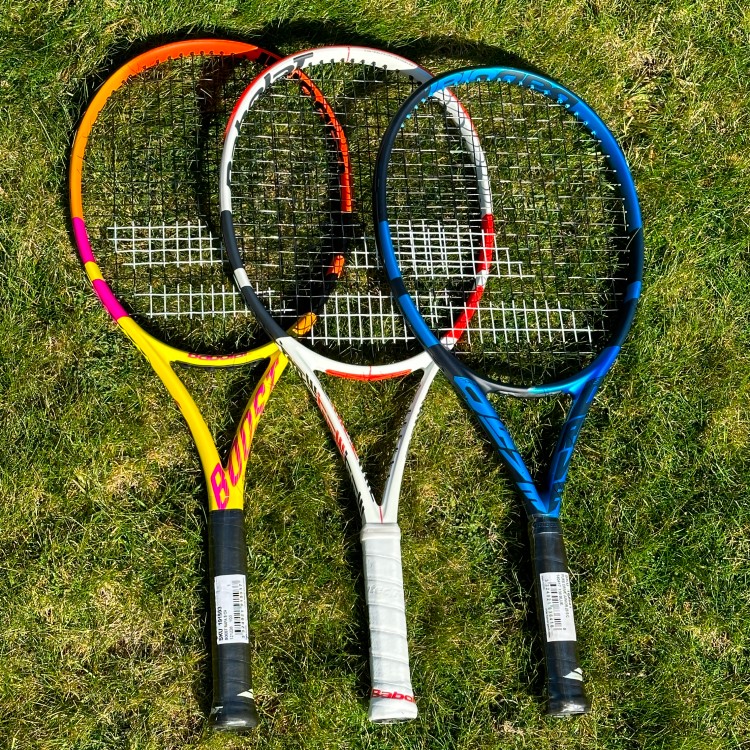
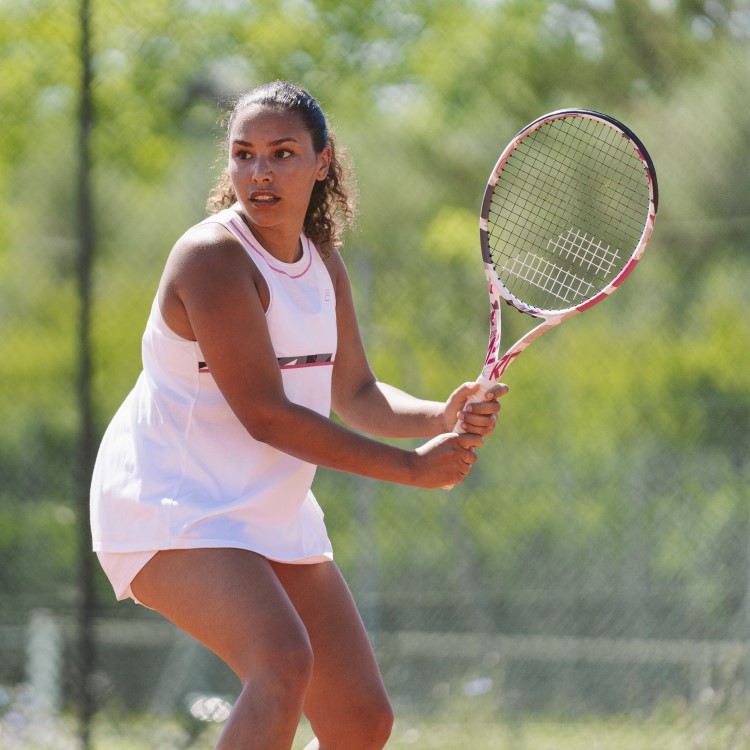
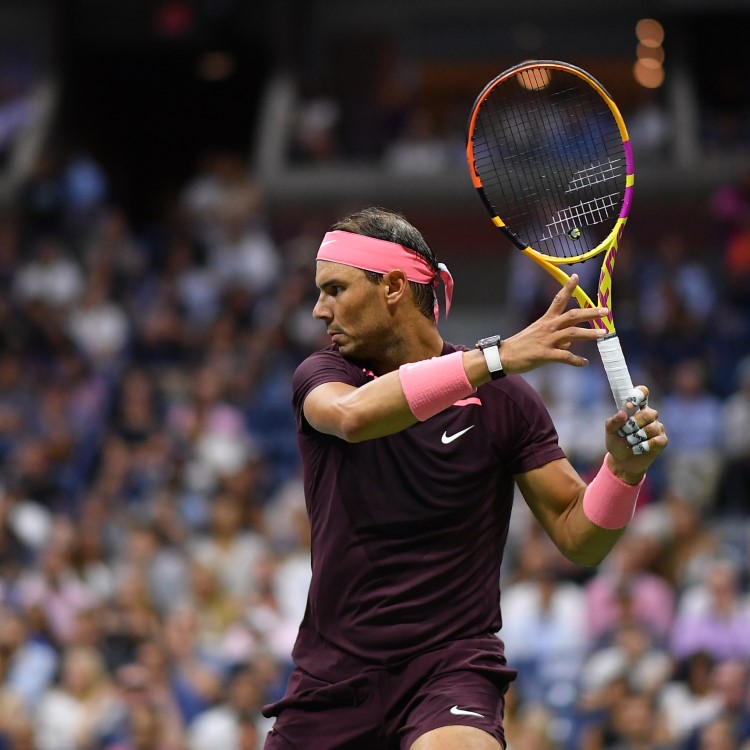
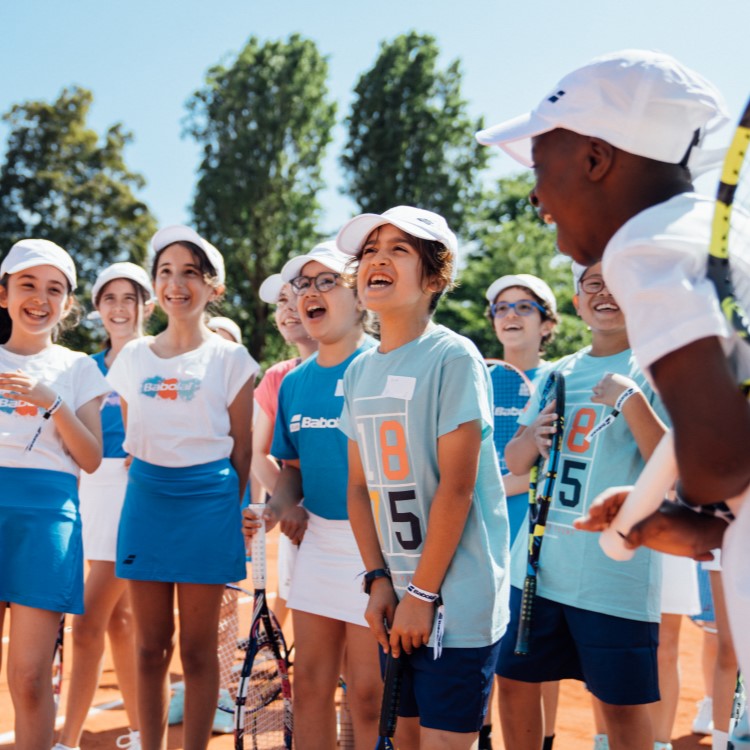
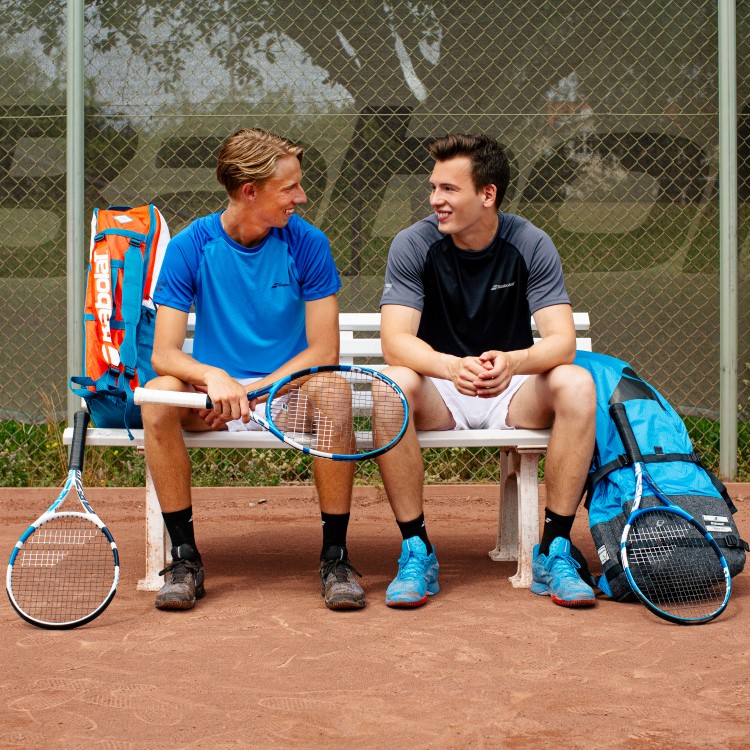
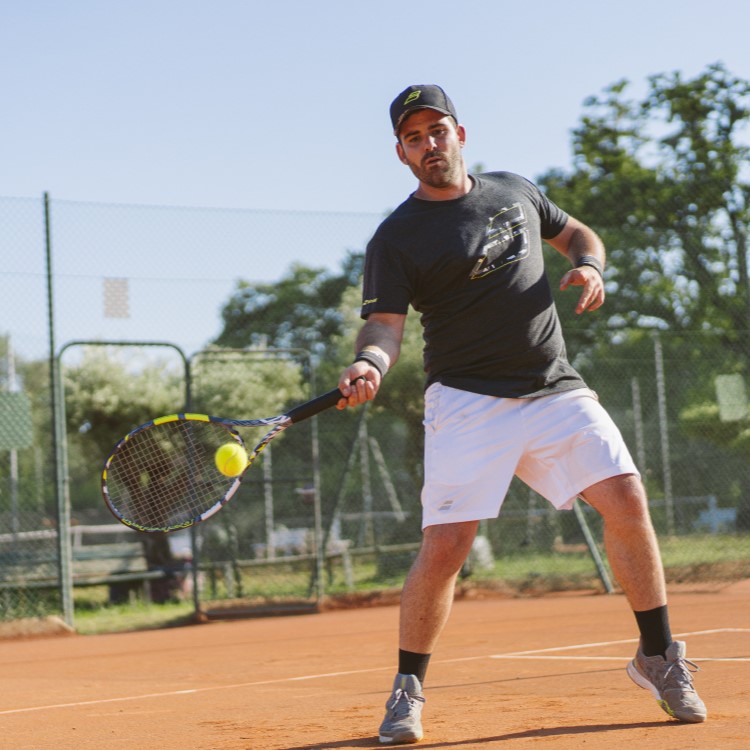
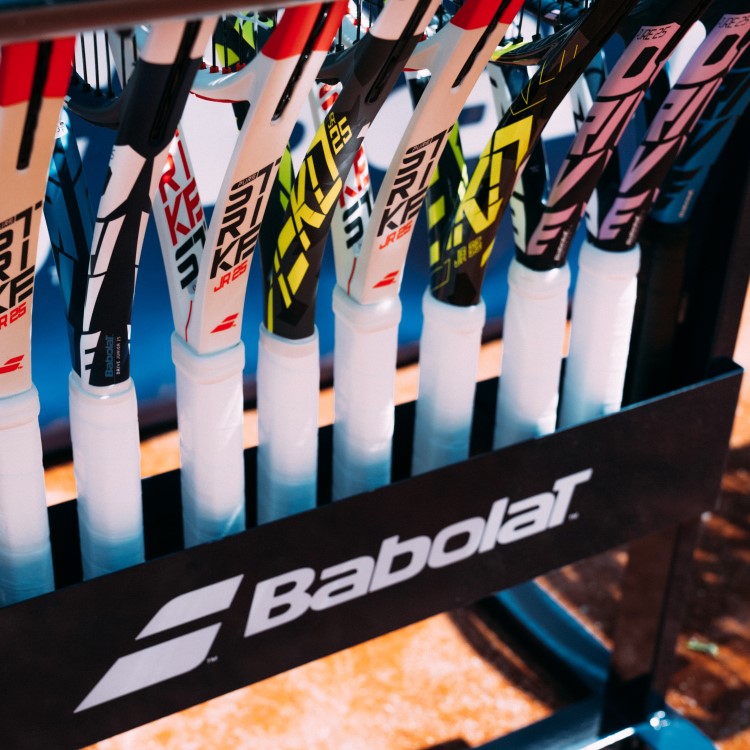
3 factors to choosing a tennis racket
It can be overwhelming to compare the wide range of rackets when shopping online. However, finding the right fit comes down to a combination of three considerations. Here is a guide and some suggestions to help you narrow down your choices.
The considerations are:
Firstly, your height, age and hand span. This affects racket length and grip size.
Next, your ability level, how often you play, and how athletic a build you are, which influences the weight, head size and balance.
And finally, your play style comes into it. Perhaps you love the thrill of a killer serve, delivering disarming spin, or is it more your style to maintain a poker face after a sneaky drop shot? Different ranges deliver to different playing preferences.
1. Length, age, grip size
Adults generally play with a 27” long racket. Older players often use an extended 27.25” to give more reach. Shorter players sometimes choose this longer length to get a more powerful serve, as it delivers more reach.
As children grow, arm strength and hand-eye coordination improve, so they need a longer racket. See the size guide here to work out what length suits your child by height/age. After age 12, children usually use an adult length but in a lighter weight (260-280g).
Smaller rackets for beginners have more aluminium (for children under ten, because it’s softer and less stressful on the arm). As racket length increases, the graphite composition increases until it’s 100% graphite. If your child is a beginner over 10 years old, rather than nine or under, it pays to buy a more expensive beginner racket that has more graphite such as the Boost or Pure Aero; graphite gives more power and strength, and is lighter with good vibration absorption. It will see you through further transitions as your game evolves.
2. Frequency, ability & budget
The first questions a specialist tennis retailer asks are “how much tennis do you want to play?” and “how much do you want to spend, ballpark?”
Frequency
You’ll need a different racket (lighter weight say 260-280g) if you plan to have a hit once a week with mates for social tennis or hit with your beginner child, versus if you want to play three times a week or play interclub (300g). Playing more often, you become fitter and your muscles can handle something heavier. A super-lightweight racket (children) might be 200-250g.
There are light rackets in all of the ranges; even the top-end rackets are available in lightweight. “The Babolat Pure Aero Rafa Lite (270g) is a weight that many female players go for. It's equally favored by teenagers aged 14 to 16 who haven’t fully filled out, as its lighter design allows for extended play without causing fatigue in the arm,” says an Auckland tennis coach.
A former Frontrunner tennis expert says “women in general seem to like the feel of a lighter racket.”
“If you haven’t played much tennis for a while, using a heavy racket when getting back into it isn’t ideal. The full spec rackets are 10% heavier, so it can be more physical and uncomfortable. On the other hand, if you’re a stronger woman player, you’re better to play with a 300g racket,” the coach recommends. “The entry level Boost or full spec rackets Pure Aero or Pure Drive are good options.”
For women or mums who play recreational tennis once a week, you’re probably not playing as consistently as if you were playing more regularly. So go for a 100 sq. inch head size but in a lighter weight 260-290g with bigger head. The bigger head gives a bigger sweet spot so your chances of a good shot are enhanced. Racket recommendation: Babolat Pure Drive Team, or Pure Drive Lite. “A lot of women use the Pure Drive as it has a slightly rounder head and is softer and more forgiving than players’ rackets like the Babolat Pure Strike, which are more about accuracy and power,” the coach advises.
For a midweek player or a dad playing doubles, a bigger person or better player who already has a longer swing (i.e. you’re generating the power – not needing the racket to generate it for you), go for Boost Strike 280g or mid tier Evo 270-280g or full spec Pure Drive 300g (if experienced).
A beginner wants to discover the game and be encouraged with some early success. An intermediate is a perfectionist who wants to improve. A competition player wants to sharpen their skills and get an edge to win. This Rafa chart is a good overview of rackets by ability.
The benefit of going up to a full spec 300g for adults – such as the Babolat Pure Drive or Pure Aero – is that around 300g is the most popular weight for experienced players, because it’s still manoeuvrable, while also doing a lot of the work for you. 300g rackets tend to be relatively stiff to give you a bit of power – a winning formula when paired with a standard head size of 100 square inches.
If you’re unsure, and you’re still an intermediate adult but taking lessons, go for the 300g rather than the 285g. It will be stable enough for you right up to an advanced level. 300g is a racket weight used by many very good players, and is the go to standard for experienced players. If you’re an Intermediate improver male, the Pure Drive 300g, 100 head size is a safe bet. Intermediate improver females try a Pure Aero Lite or Pure Drive Lite with a 270g 100” head.
Our Auckland tennis coach says, “If you go to the gym, are physically strong and playing 3 or 4 times a week, or if you play more traditional flat strokes rather than top spin, the 300g weight helps. It does a lot of the work for you.“
Male players who love a nifty volley at the net often opt for the 285g. Being lighter, you can react faster without the weight of a heavier racket slowing your reaction (we’re not supposed to swing at the net anyway, are we!) At this weight, you can whip it through the air quickly, creating a captivating star shot.
Head size: the standard players’ racket has 100 square inches as a baseline good head size; you want this or lower if you are engaged in performance play. Professionals will use 95-98 square inches. For older players though, Babolat recommends getting a larger sweet spot around the head for crafty returns, so a head size upwards of 105 or 110, even 115 delivers an undercover advantage.
How much to budget for an adult tennis racket
Entry-level adult tennis rackets will cost between $180-$250. Consider Babolat Pulsion, Boost Aero or Boost Drive.
Mid-range adult tennis rackets cost $330-$360 such as Babolat Evo Aero or Evo Drive.
Full-spec adult tennis rackets cost from $420-480 such as Babolat Pure Aero Rafa, Pure Drive or Pure Strike.
Advanced players should expect to pay $480-$550 NZD for a top end racket. Such a racket has the technology, balance and materials to provide a level of playing experience for the player who’s really striking the ball, such as Pure Strike VS (accuracy), Pure Aero VS (spin) or Pure Drive VS (power).
Babolat offers really good value in rackets because “they offer more features at the same price point,” said our former-Frontrunner tennis expert.
Whilst the entry level rackets are cheaper, the lowest price the Auckland tennis coach suggests you pay for an adult racket is $220-$250; “Any lower, and it will be all aluminium, have poor balance, and give you a poor experience” The coach says you’d have to spend $70 to get it restrung straight away and the racket might not be re-stringable later.
3. Playstyle
Tennis Rackets for better spin control
Consider a Babolat Pure Aero Rafa, designed in collaboration with Rafael Nadal. Babolat rackets are slightly stiffer than other brands, which gives them more power and more spin.
If you are a strong spin player hitting the ball at peak of the bounce, drawing on your personal strength rather than ball speed to rotate the ball, look at the Pure Aero. The Pure Aero Lite is a lighter option for females or slender-build women.
If you are a heavy spin player who makes contact as the ball is coming down from the top of the bounce, imparting spin from the baseline with explosive power – just like Rafael Nadal – try the Pure Aero Rafa Origin.
Tennis rackets to increase Power:
The Drive Range is great for more power. It’s light and easy to use, great for anyone with an aggressive, attacking playstyle. It’s also popular for intermediates (Lite model) to improve length. It’s slightly more forgiving and powerful than Pure Aero. The slightly lower swing weight makes it easy to swing, which can be a big advantage for intermediate players who are looking to add more pace to their shots. Suits a wide variety of players. Good combo of power and manoeuvrability.
Tennis rackets for precision shots
Too many shots landing outside the court? If you’re really wanting more precision, consider the Strike range. This will help your game a lot. The Strike suits players who have a solid technique, strong physique, and can generate good amounts of power on their shots but want better control and precision. Not the choice if you’ve had tennis elbow. Good for players who prefer a faster racket. A real weapon for down the line in forehands.
Should you choose a racket based on colour?
Tennis pros will say it’s best to narrow your selection based on rackets that suit your ability, size and playing style. It has to be acknowledged, though, that some cool colour combos are irresistible. Colour is a motivational factor, according to tennis champion, Rafael Nadal, who says “it’s important to be happy when you are on court.”
Nadal worked with Babolat to design the powerful and strong colours in the Pure Aero Rafa range. Nadal has designed the Rafa range with rich tones of sunflower yellow with a burst of fuschia, set against a titan grey with a touch of baby blue. “It’s a happy racket – a great racket to have fun playing tennis,” said Rafael Nadal.
A top sports goods buyer confirmed that the Pure Aero Rafa is a real “player’s racket” i.e. you don’t have to be a pro to be able to really shine with this racket.” It’s a limited piece so get in quick, as only a few are coming into New Zealand. It comes in three models: a Junior 26”, a full size 290g racket, or the 317g Pure Aero Rafa Origin for the super duper seriously advanced players. The Rafa tennis bags and backpacks have a funky design too in the same colourway. If you love good design, then the Rafa collection by Babolat has to be high on your shopping list.
One of the more popular colour choices is the Aero which comes in charcoal, yellow and white.
I’ve heard it said by more than one tennis retailer that pink tennis rackets are popular with young girls, teenage girls and women. Far from being garish, the Babolat Boost Aero Pink and Evo Aero Pink are sophisticated designs with a fresh white, grey and pink combo on the frame that will add panache to any tennis fashionista’s outfit.
Babolat certainly has some chic colourways – the French are renowned for their flair, afterall. Looking stylish and loving your gear boosts enthusiasm and confidence. That has to be good for your game. And it’s good to know it’s not just the colours that are well considered; both Rafa Nadal and Carlos Alcaraz choose to play with Babolat.


